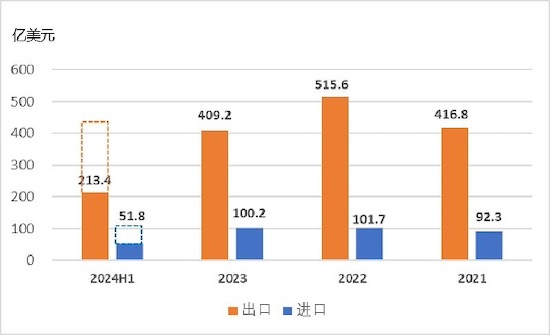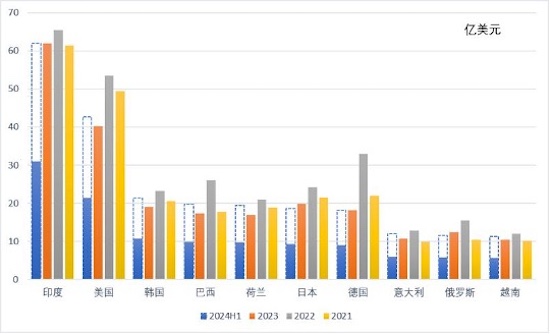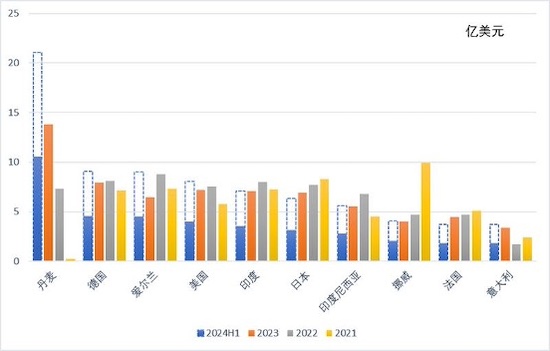Analysis and Prospect of Import and Export Situation of Raw Materials in the First Half of 2024
August 31, 2024
Source: drugdu
 510
510
In the first half of 2024, the total import and export volume of raw materials in China reached 26.52 billion US dollars, a year-on-year increase of 0.6%. Among them, the export value was 21.34 billion US dollars, a slight increase of 0.1% year-on-year; The import volume was 5.18 billion US dollars, a year-on-year increase of 2.8%.
1. Overall Overview and Trend Analysis
As the main raw material products in the category of Western medicine import and export products in China, active pharmaceutical ingredients account for 50% of Western medicine foreign trade. From the perspective of exports alone, raw materials account for 80% of the export of Western medicine products.
From the import and export situation since 2021, it can be seen that the global demand for active pharmaceutical ingredients has rapidly increased due to the epidemic. In 2022, the foreign trade of active pharmaceutical ingredients reached a historical high, with a total import and export volume of 51.56 billion US dollars. 2023 is the first year of normalization of the epidemic, with a decline in overseas market demand and pressure to reduce inventory, resulting in a significant year-on-year decline of over 20% in the export value of active pharmaceutical ingredients. In the first half of 2024, the export value of active pharmaceutical ingredients was 21.34 billion US dollars, which was basically the same as the same period last year. From the current trend, the export value of raw materials for the whole year of 2024 is expected to remain the same as that of 2023, indicating signs of market stability. From the perspective of the export quantity of raw materials, there is a significant difference in the trend of export value. From 2021 to 2023, the export of active pharmaceutical ingredients continued to grow, with a compound growth rate of 6.8%. The export volume of active pharmaceutical ingredients in the first half of 2024 increased by 23.4% year-on-year, and is expected to continue to rise throughout the year. It can be seen that the current global market demand for active pharmaceutical ingredients is strong, and the years of technological accumulation, agglomeration effect, and cost advantage of China's active pharmaceutical ingredient industry have driven China's active pharmaceutical ingredient to quickly meet market demand, further increasing the export volume of active pharmaceutical ingredients. We also see that the competition in the raw material pharmaceutical industry is becoming increasingly fierce, with a significant decrease in export prices. This also leads to a steady increase in export volume, but the export amount remains relatively stable.
From the perspective of the export quantity of raw materials, there is a significant difference in the trend of export value. From 2021 to 2023, the export of active pharmaceutical ingredients continued to grow, with a compound growth rate of 6.8%. The export volume of active pharmaceutical ingredients in the first half of 2024 increased by 23.4% year-on-year, and is expected to continue to rise throughout the year. It can be seen that the current global market demand for active pharmaceutical ingredients is strong, and the years of technological accumulation, agglomeration effect, and cost advantage of China's active pharmaceutical ingredient industry have driven China's active pharmaceutical ingredient to quickly meet market demand, further increasing the export volume of active pharmaceutical ingredients. We also see that the competition in the raw material pharmaceutical industry is becoming increasingly fierce, with a significant decrease in export prices. This also leads to a steady increase in export volume, but the export amount remains relatively stable.
In terms of imports, from 2021 to 2023, the import amount of active pharmaceutical ingredients remained relatively stable, fluctuating around 10 billion US dollars. The import amount of active pharmaceutical ingredients in the first half of 2024 was 5.18 billion US dollars, a year-on-year increase of 2.8%. It is expected that the import volume for the whole year of 2024 will maintain a stable growth rate of 2-3%. The trend of import quantity and import amount is similar, basically maintaining around 2 million tons.
2. Product: Stable export of bulk active pharmaceutical ingredients and good import growth trend
In the first half of 2024, the top three categories of raw materials for API exports, namely amino acid, antibiotic, and vitamin raw materials, maintained a trend of both increasing value and quantity, with export values of 2.26 billion US dollars, 1.76 billion US dollars, and 1.51 billion US dollars, respectively.
In contrast, antipyretic and analgesic products have experienced a price drop of nearly 25%. Although the export quantity has not decreased significantly, the export value has decreased by over 27%. The export trend of antipyretic and analgesic raw materials since 2022 shows that the global market demand is in an oversaturated state. Since the peak of antipyretic and analgesic raw material exports in China in 2022, the export volume of antipyretic and analgesic raw materials has gradually decreased since 2023. However, the domestic inventory and production capacity are sufficient, and the supply-demand mismatch has led to a continuous decline in prices. Table 1 shows the year-on-year changes in export prices of ibuprofen, paracetamol, antipyrine, and aspirin in 2023 and the first half of 2024. It can be seen that the supply-demand imbalance of paracetamol is the most severe, with the largest price decline.
It is worth noting that the export of anti tuberculosis drugs has significantly increased. The export of rifampicin and its derivatives reached 220 tons, a year-on-year increase of 56.5%; Ethambutanol exported 343 tons, a year-on-year increase of 977%. The WHO Global tuberculosis Report 2023 points out that after the end of the COVID-19, tuberculosis appears to ease the pandemic trend. The Stop tuberculosis Partnership calculates that the COVID-19 may lead to 6.3 million new tuberculosis cases and 1.4 million tuberculosis related deaths between 2020 and 2025. From the perspective of China's anti tuberculosis drug export market, India is the largest market all the year round, which is closely related to its 27% share of tuberculosis in the world. It is worth noting that in the first half of 2024, the number of anti tuberculosis drugs exported by China to the Brazilian market will increase by 45% year on year, and the Brazilian market will become the second largest market. In addition, the import volume of Vietnam, Pakistan, Mexico, and Egypt markets has also increased significantly, with growth rates of 62%, 70%, 32%, and 304% respectively, ranking among the top ten markets.
In terms of raw material imports, peptide hormone raw materials represented by insulin analogues dominate the market. The HS codes of other peptide hormones in which they are located had an import value of 1.23 billion US dollars in the first half of the year, accounting for 13% of the total import value of raw materials, driving the overall stable growth of raw material imports.
3. Market: Overall stable exports, new momentum demonstrated by imports
In the first half of 2024, India and the United States will remain the top two markets for China's raw material exports. China exported raw materials worth $3.1 billion to India, a year-on-year decrease of 3.8%, and $2.13 billion to the United States, a year-on-year increase of 0.3%. Following closely behind are the second tier markets, including South Korea, Brazil, the Netherlands, Japan, and Germany. In the first half of the year, China's total exports to these countries remained at around 1 billion US dollars. In addition, the third tier markets such as Italy, Russia, and Vietnam have also shown strong demand for China's raw material pharmaceutical products, with their respective export volumes stable between $500 million and $600 million.
 In terms of the import market, the Danish market has emerged as a rising force, and in just two years, it has become the largest import market for Chinese raw materials. In the first half of 2024, I imported raw materials worth 1.05 billion US dollars from the Danish market, a year-on-year increase of 96.3%. In the second half of the year, I am expected to continue to push forward and lead the import of raw materials in China.
In terms of the import market, the Danish market has emerged as a rising force, and in just two years, it has become the largest import market for Chinese raw materials. In the first half of 2024, I imported raw materials worth 1.05 billion US dollars from the Danish market, a year-on-year increase of 96.3%. In the second half of the year, I am expected to continue to push forward and lead the import of raw materials in China.
The pharmaceutical industry in Ireland has developed rapidly in recent years. Ireland, with its stable political and economic environment, favorable tax policies, highly skilled workforce, and strong research and development capabilities, has attracted numerous international pharmaceutical companies to establish production bases here. Among the top 25 pharmaceutical companies in the world, 24 have invested and set up factories in Ireland, including Pfizer, Johnson&Johnson, Roche, Novartis, and AbbVie. Ireland has also attracted multiple Chinese companies, including WuXi Biologics, to invest in Ireland. In the past two years, Ireland has also been promoted to the top tier market for active pharmaceutical ingredients. In the first half of 2024, China imported $450 million worth of active pharmaceutical ingredients from the Irish market, a year-on-year increase of 112%, with great growth potential.
 4. Outlook
4. Outlook
In the macro context of global economic stagnation, pharmaceutical raw materials, as rigid demand products related to public health, are relatively less affected by fluctuations in their market and show a relatively stable growth trend. Although the growth rate of the global pharmaceutical market has slowed down, it continues to move forward at a steady pace. With the expiration of patented drugs, the generic drug market continues to usher in new development opportunities, providing new market space for active pharmaceutical ingredient companies.
Starting from 2023, the competition in the raw material drug market will become increasingly fierce, and price wars have become a common strategy for competing for market share, especially in the field of bulk raw materials. The competition in domestic and foreign markets has become almost white hot. In the overseas market, Indian buyers have exerted significant pressure on prices, and the impact of the Production Linked Incentive (PLI) program on the Indian pharmaceutical industry chain is also subtly underway. Although the long-term impact of this policy remains to be observed, it undoubtedly intensifies the competitive situation in the international market. At the same time, the quality assurance accumulated by Chinese raw material pharmaceutical companies after years of market testing still has advantages in the global market.
Faced with the increasingly shortened product lifecycle and rapidly changing market demand, it has become increasingly difficult for enterprises to maintain long-term competitive advantage solely by relying on a single variety. Therefore, the deepening of strategic planning and the diversified expansion of product pipelines have become the key to the sustainable development of enterprises. Enterprises need to actively explore the market potential in the field of characteristic active pharmaceutical ingredients, open up new growth points, and respond to fierce market competition with differentiation strategies on the basis of consolidating their existing market share.
In the first half of 2024, although China's raw materials have shown strong resilience in foreign trade, the uncertainty of the international political and economic situation, as well as the shift from globalization to a regional industrial chain pattern, indicate that China's raw materials foreign trade will face more severe challenges. This requires our company to continuously strengthen technological innovation, improve product quality, and actively respond to changes in the international market to maintain competitiveness.
Source: https://www.cccmhpie.org.cn/Pub/1757/184209.shtml
By editorRead more on
- Multiple batches of quadrivalent influenza virus split vaccine have been sub-packaged and submitted for lot release approval; expected to be released to the market soon after approval December 12, 2025
- Ab&B Bio-Tech CO., LTD. JS Lyophilized Human Rabies Vaccine Initiates Phase III Clinical Trials December 12, 2025
- The ‘Sweetest’ HPV Vaccine Market is Gone | Haibin Interview December 12, 2025
- InnoCare Pharma announced that its first independently developed next-generation TRK inhibitor, zoletrazinib, has been approved for marketing in China December 12, 2025
- Is PD-1/VEGF dual antibody + ADC becoming the standard configuration? December 12, 2025
your submission has already been received.
OK
Subscribe
Please enter a valid Email address!
Submit
The most relevant industry news & insight will be sent to you every two weeks.



